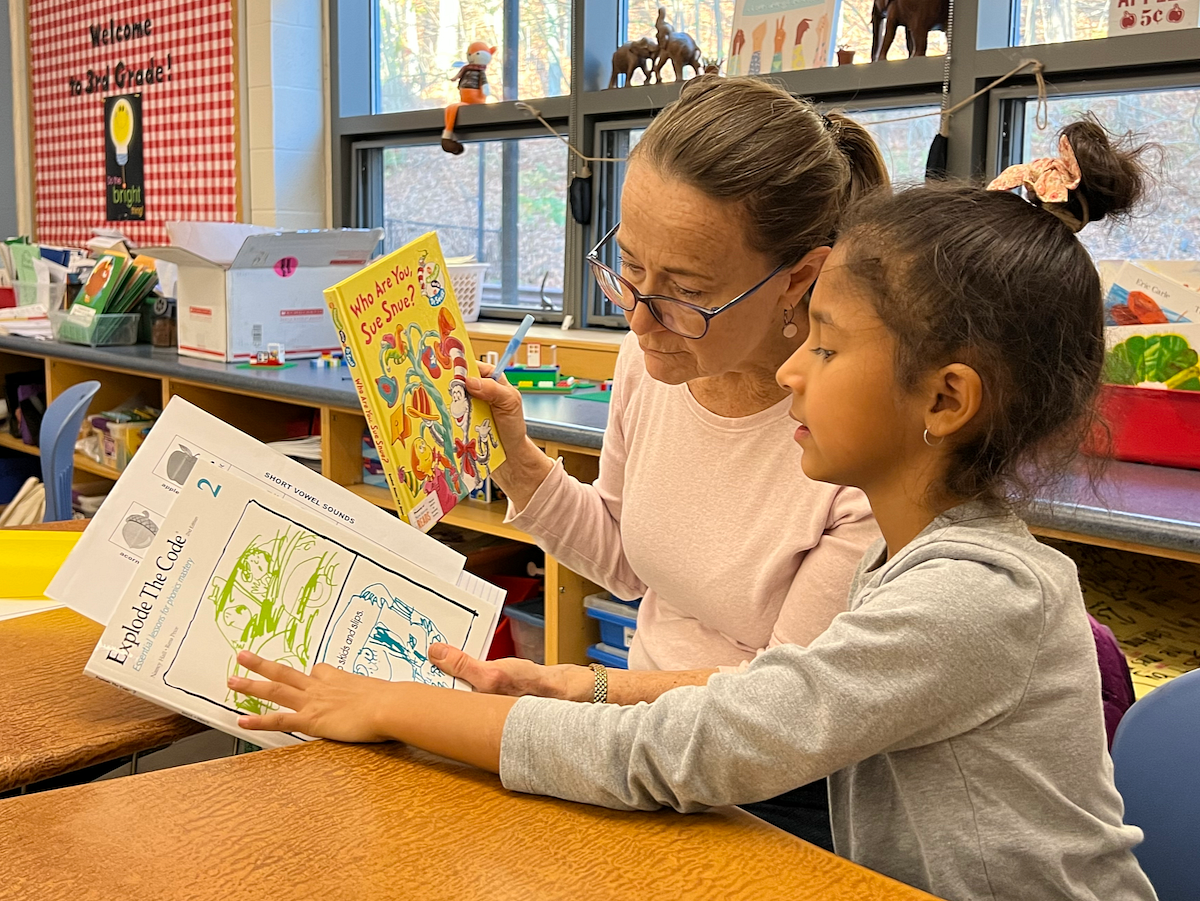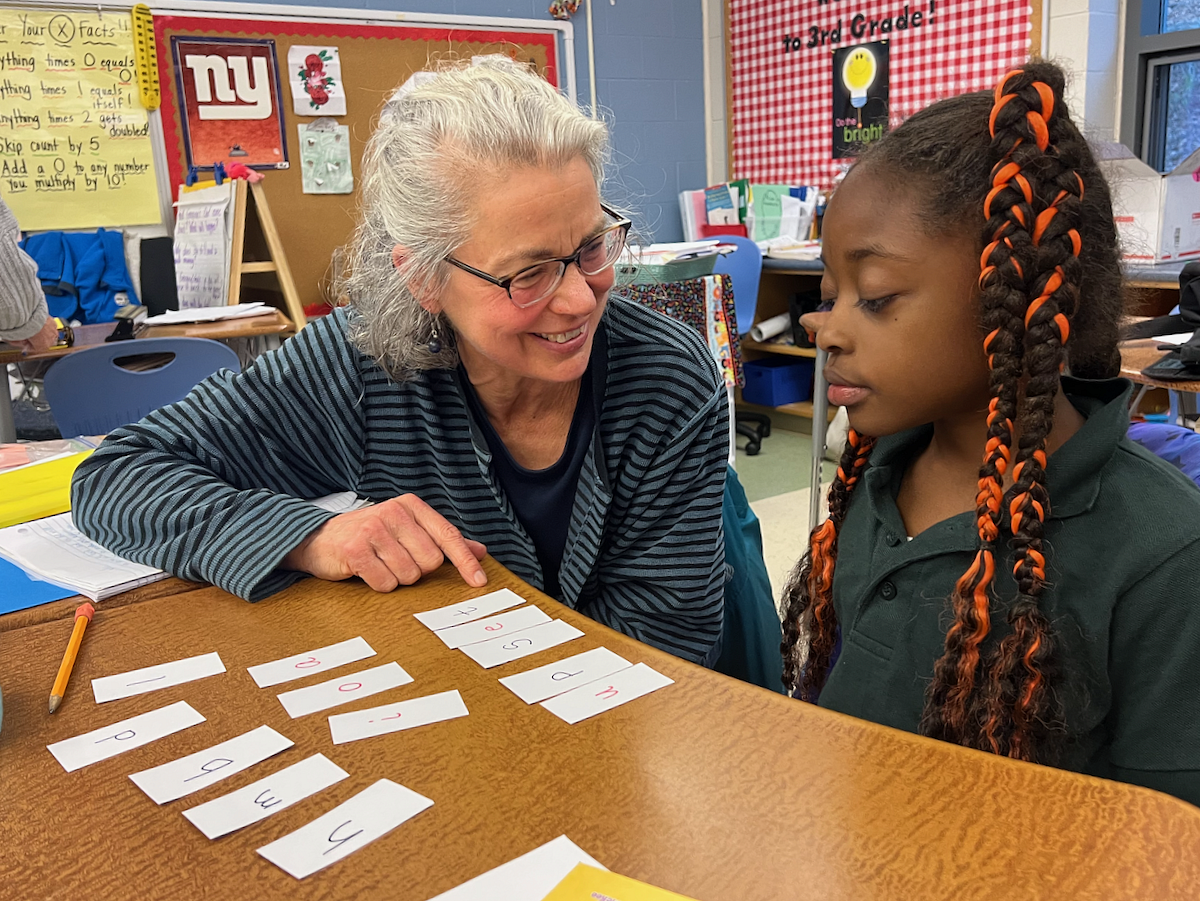
Maya McFadden file photo
Shelley Smith tutors second grader Maite at Bishop Woods Thursday.
Bishop Woods second grader Maite paused and took a deep breath as she looked at the word: “Dent.”
She knew what it meant. The spelling was the hard part. So she decided to sound it out — at the suggestion of a tutor from a successful New Haven nonprofit that has been called in to help the city’s public schools up their reading game.
Maite worked her way towards that reading comprehension on Thursday during a session with literacy tutor Shelley Smith.
The two sat side by side in one corner of a Bishop Woods classroom that was full of students like Maite and New Haven Reads tutors like Smith. Smith and Maite are one of 10 total tutoring duos at the local literacy nonprofit’s newly opened tutoring site at Bishop Woods School at 1481 Quinnipiac Ave.
The Bishop Woods site operates as an after-school program for the New Haven Public Schools (NHPS) elementary school in the Quinnipiac Meadows/Bishop Woods neighborhood.
The site opened on Oct. 11 for 10 Bishop Woods students to receive tutoring twice a week (on Tuesdays and Thursdays) from volunteer tutors through the nonprofit’s one-on-one, science-of-reading focused program.
New Haven Reads has three additional sites throughout New Haven that also base its one-on-one tutoring model in structured literacy, a pedagogical approach that prioritizes sounding out words over guessing what those words might be based on context and repetition.

Maya McFadden photo
New Haven Reads Executive Director Kirsten Levinsohn practices word making with third grader Maliah.
“We are very much in favor of structured literacy and see the benefits of the approach firsthand,” New Haven Reads Executive Director Kirsten Levinsohn told the Independent in response to a follow-up email request for comment about the tutoring nonprofit’s approach to teaching reading.
“Our RISE program (Reading Interventions for Success Every day) supports students who require an intensive approach and is very much a structured literacy program with explicit, sequential, differentiated instruction,” she wrote. “We work with those students one-on-one (10 at this time) three times a week with the support of a mentor from Literacy How. A modified approach of RISE is our Ascend program that incorporates phonemic awareness activities alongside our usual activities including decoding, spelling, writing and reading comprehension.” And she said that New Haven Reads’ “traditional program,” known as “Aspire,” which includes the bulk of the nonprofit’s students, also focuses on “aspects of structured literacy” and that New Haven Reads is “actively incorporating even more aspects of the Science of Reading into this program as well.”
Levinsohn said that New Haven Reads’ “assessment results” from October 2021 to May 2022 found 100 percent of participating students improved in their reading skills, 90 percent of students improved their reading comprehension scores, and 75 percent of students improved their reading levels by one or more grade levels.
“The Science of Reading works!” she wrote.
The literacy nonprofit’s focus on a science-based approach to teaching reading comes as the public school district that adopted a new literacy plan which officials claim will shift towards a more phonics-based “structured” reading program.
That change of course came after NHPS’ preliminary reading and math assessment data from last school year showed that 84 percent of third-graders were reading below grade level. The Board of Education, alders, clergy, and other community members dubbed the scores a “crisis,” and demanded new plans to address the“emergency.” At the center of that debate has been a larger controversy about how NHPS teaches students to read. Claiming that the old way of teaching doesn’t need to be overhauled, officials, including the superintendent and several board members, previously pushed back against a new state requirement that all schools move from “balanced” to more phonics-based “structured” literacy in the face of new brain research on how kids learn to read.
"What's The 3rd Sound You're Hearing?"

Thursday's after school tutoring at Bishop Woods.
On Thursday, Maite worked on a computer sounding out words through the program Lexia alongside Smith.
Maite sped through the phonological lesson, pausing to sound out only a few words like “fist” and “milk.”
As the computer program read the word “dent” aloud, Maite looked through an assorted bank of letters to spell the noun.
“Da-en‑t,” Smith said aloud to Maite who used her computer mouse to drag the first three letters “D” “E” and “N” to their appropriate places for the four letter word.
“What’s the third sound you’re hearing?” Smith asked before repeating the pronunciation of the final word for the lesson.
“T,” Maite declared while dragging the letter to the last line to make up the word.
“Wow, that was so good, you did this one fast,” Smith said with a smile of encouragement.

Maite and Smith then moved on to choosing their next objective for the session. Maite decided between reading the Dr. Seuss book “Who Are You, Sue Snue?” or a phonics workbook. She went with the workbook.
While Smith found their place in the workbook, Maite continued to work on Lexia for every second possible.
In the workbook Thursday, Maite worked on spelling by first looking at a picture of an object or action then by decoding the spelling of the word with the provided phonetic sound pairs. She then wrote the complete word out.
Maite sped through sounding out, decoding, and spelling words like “dress,” “drum,” “drag” and “crack.”
Associate Education Director Charlene Cua and site coordinator Lea Pierson oversaw Thursday’s nine tutor pairings that worked on an hour-long schedule organized into four parts.
The tutors and students first work together on three main objectives during their sessions: reading aloud, completing computer exercises through the structured literacy program Lexia Learning, and then completing workbook exercises centered on goals like comprehension and fluency.
In January, the team plans to expand its partnership with the public school by taking on a second cohort of Bishop Woods students to tutor twice a week on Mondays and Wednesdays. The second cohort will accept 10 – 12 students from New Haven Reads’ waitlist of more than 100 students.
“We want to partner to reach as many kids as we can,” Cua said.
"EE," "OO", or "OW"

Christina Herrica and Mariah work on sounding out words with Lexia Learning.
In another tutor pairing on Thursday, third grader Mariah worked with tutor Christina Herrica.
At around 3:50 p.m. the pair had completed their workbook task and had moved on to doing a Lexia lesson on sounding out words from a full sentence.
Mariah began by reading the sentence while leaving a blank for the not-yet-complete word.
Mariah read the sentence “I t _ _ k the pan from the shelf” aloud and jokingly took some random word guesses for the blank like “put” and “dropped.”
While looking closely at the provided letters to fill the blank which were “ee,” “oo” or “ow” Mariah began to fill the blank with each option.
“Tea‑k” Mariah said aloud.
“I don’t think that’s it. Let’s try a different one,” Herrica said.
“T‑ook” Mariah corrected.
“Oh! They took the pan,” she exclaimed while dragging the “oo” into the blank space.
“Yes, you got it,” Herrica said.
“I know I got it,” Mariah responded with a smile.
After completing the Lexia lesson the pair moved on to reading a book about otters.
Mariah immediately called dibs on reading aloud. While reading she worked with Herrica to sound out words like “energy,” “pockets” and “pouch.”
When heading out for dismissal, Mariah described the after school program as “helpful” and “fun.”
"Good Enunciation"

Fifth grader Victor reads Dog Man graphic novel with tutor Daniel Bogaev.
Across the room were tutor Daniel Bogaev and fifth grader Victor.
Victor read chapter seven of the graphic novel Dog Man: For Whom the Ball Rolls by Dav Pilkey.
While reading aloud the sentence “Well don’t just stand there like a statue, invite me in” from the book, Victor paused at the word “statue” and sounded it our carefully with the help of Bogaev.
While he immediately got the first syllable of the word, Bogaev helped him to pronounce the second syllable to completely pronounce it as “sta-tue.”
Victor reread the sentence before continuing on to pronounce the word with more confidence this time around.
“Good enunciation,” Bogaev cheered.
Throughout reading the book, Bogaev would occasionally pause Victor to ask: “What’s happened so far?”
The duo paused at a sentence that used the word “demonstrate.” Bogaev asked Victor, “What does that even mean?”
Victor confidently answered, “It’s like: ‘Let me show you.’ ”

Bogaev and Victor play Rush Hour for choice time.
After completing their three main objectives, Bogaev and Victor spent the final 10 minutes of the session, called ‘choice time,” playing the brain game “Rush Hour Traffic Jam.”
The game focuses on special awareness and STEM concepts as the players try to figure out how to unblock a dozen cars from a traffic jam. The duo took turns trying to get a single red car unblocked from the plastic traffic jam.
The after school site at Bishop Woods School is New Haven Reads’ fourth site in New Haven.
Levinsohn said the after-school partnership planning began last spring to help address the city’s youth reading gaps.
She said the nonprofit’s goal is to expand the program to more school sites to support parents who don’t always have access to transportation to the programs’ other three sites, which are in Dixwell and Science Park.
“We know we’re missing some of the kids who have parents who are working or have transportation concerns,” Levinsohn said.
With the new site, the Bishop Woods students are dismissed from their the school day at 3 p.m. and then begin the New Haven Reads program at 3:30 p.m.
Currently New Haven Reads has a “tremendous need” for volunteer tutors. Its student waitlist will likely only grow as the nonprofit expands its after-school program with new public school partnerships. (Click here to apply to be a tutor.)
For the planned January expansion at Bishop Woods, the program will need 10 to 20 more tutors. Throughout the four sites there’s a need for 63 total tutors for the currently scheduled students.
New Haven Reads partnered with Bishop Woods staff liaison Stephanie Willis to make the current after-school program a reality.
Third grader Maliah and New Haven Reads Executive Director Kirsten Levinsohn worked on identifying and spelling words from a select batch of vowels and consonants on Thursday.
While Levinsohn said aloud words like “hit” and “bat,” Maliah used the papers to spell them out.
At the start of the program, Levinsohn intended to work with Maliah only as a substitute until a permanent tutor was available. But because the duo have worked together for the past month, Levinsohn said, “I don’t want to leave her side now.”
While packing up her bag to head home, Maliah told this reporter that she loves to read despite its difficulty at times because “it’s a lot of fun to get to learn new words.”
See below for information about a panel discussion that New Haven Reads is co-sponsoring on Dec. 6 at Barack Obama School all about the Science of Reading.





NH Reads really needs volunteers, particularly with the new site opening. The commitment can be as little as one hour per week for the school year. The kids, and their parents, appreciate the work. https://newhavenreads.org/